AMD FX-8320E CPU Review: The Other 95W Vishera
by Ian Cutress on January 13, 2015 10:00 AM ESTProfessional Performance: Windows
Agisoft Photoscan – 2D to 3D Image Manipulation: link
Agisoft Photoscan creates 3D models from 2D images, a process which is very computationally expensive. The algorithm is split into four distinct phases, and different phases of the model reconstruction require either fast memory, fast IPC, more cores, or even OpenCL compute devices to hand. Agisoft supplied us with a special version of the software to script the process, where we take 50 images of a stately home and convert it into a medium quality model. This benchmark typically takes around 15-20 minutes on a high end PC on the CPU alone, with GPUs reducing the time.
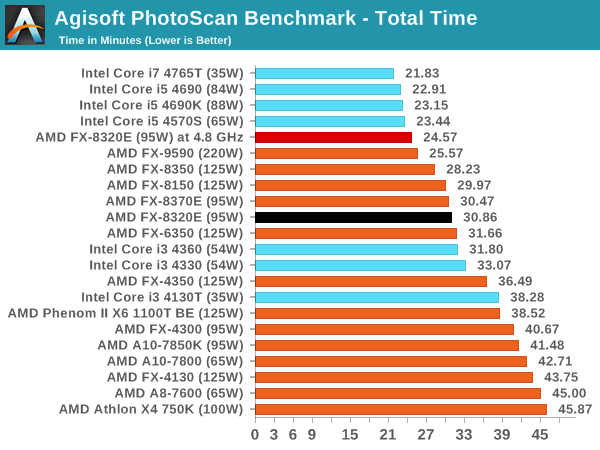
A highly parallel benchmark like Photoscan puts the FX CPUs ahead of our i3 results. When overclocked, it plays just behind the i5 results.
Cinebench R15
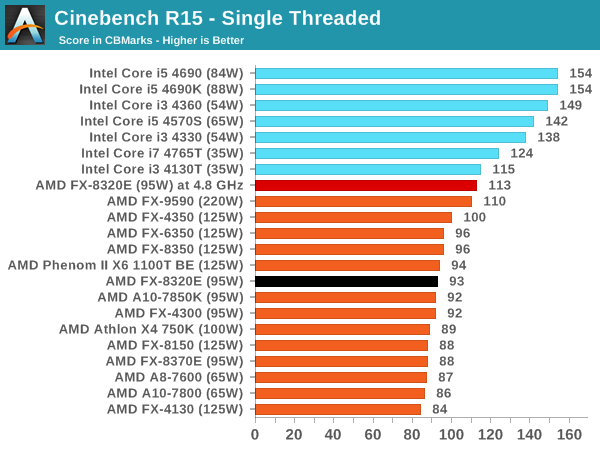
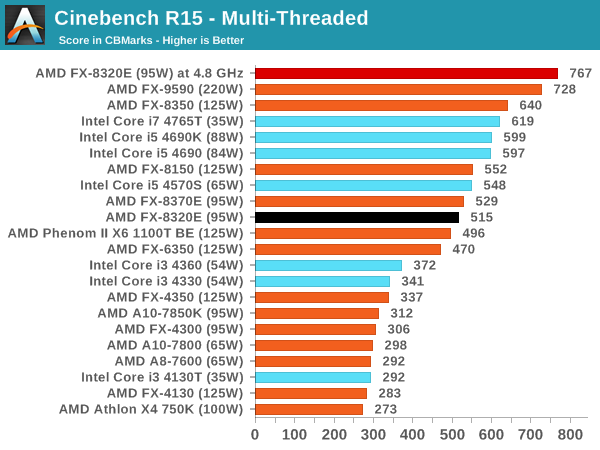
Professional Performance: Linux
Built around several freely available benchmarks for Linux, Linux-Bench is a project spearheaded by Patrick at ServeTheHome to streamline about a dozen of these tests in a single neat package run via a set of three commands using an Ubuntu 14.04 LiveCD. These tests include fluid dynamics used by NASA, ray-tracing, molecular modeling, and a scalable data structure server for web deployments. We run Linux-Bench and have chosen to report a select few of the tests that rely on CPU and DRAM speed.
C-Ray: link
C-Ray is a simple ray-tracing program that focuses almost exclusively on processor performance rather than DRAM access. The test in Linux-Bench renders a heavy complex scene offering a large scalable scenario.
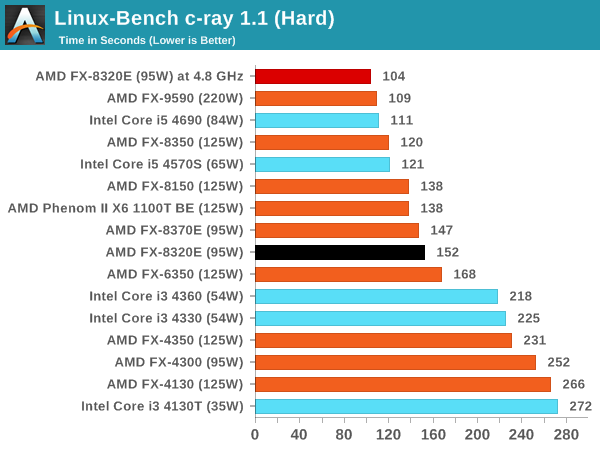
Ahead of the i3, behind the i5 until overclocked seems to be a good motto for this CPU.
NAMD, Scalable Molecular Dynamics: link
Developed by the Theoretical and Computational Biophysics Group at the University of Illinois at Urbana-Champaign, NAMD is a set of parallel molecular dynamics codes for extreme parallelization up to and beyond 200,000 cores. The reference paper detailing NAMD has over 4000 citations, and our testing runs a small simulation where the calculation steps per unit time is the output vector.
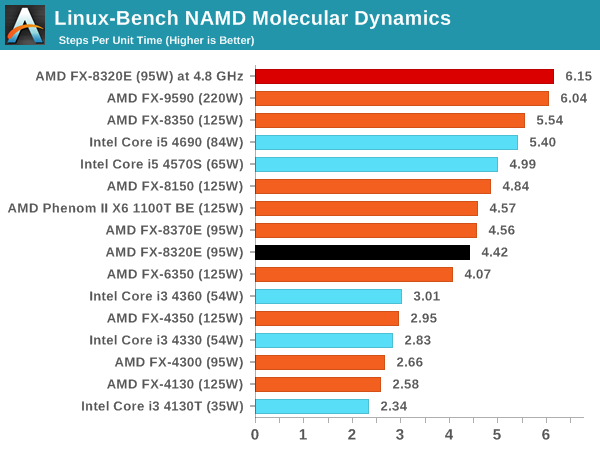
NPB, Fluid Dynamics: link
Aside from LINPACK, there are many other ways to benchmark supercomputers in terms of how effective they are for various types of mathematical processes. The NAS Parallel Benchmarks (NPB) are a set of small programs originally designed for NASA to test their supercomputers in terms of fluid dynamics simulations, useful for airflow reactions and design.
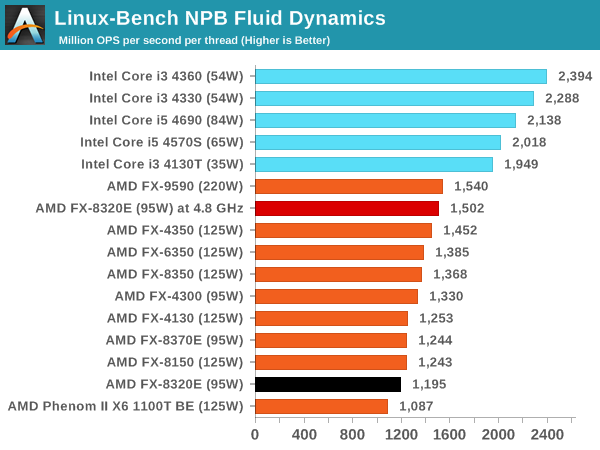
Redis: link
Many of the online applications rely on key-value caches and data structure servers to operate. Redis is an open-source, scalable web technology with a b developer base, but also relies heavily on memory bandwidth as well as CPU performance.
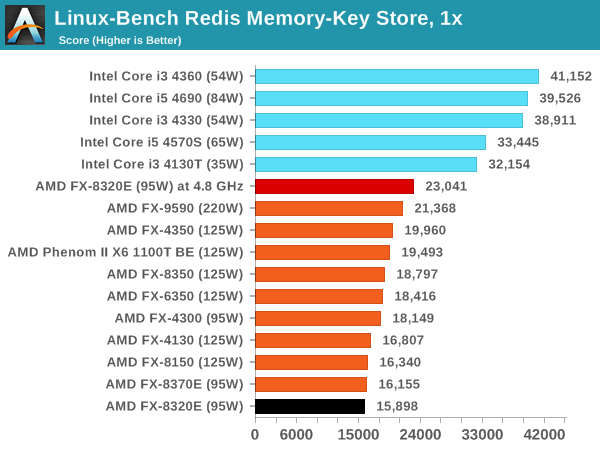
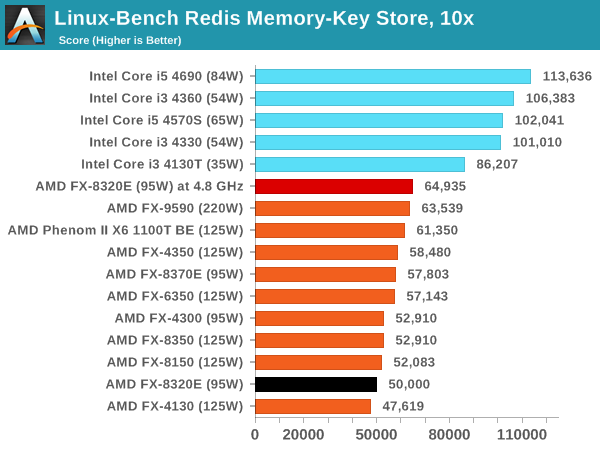
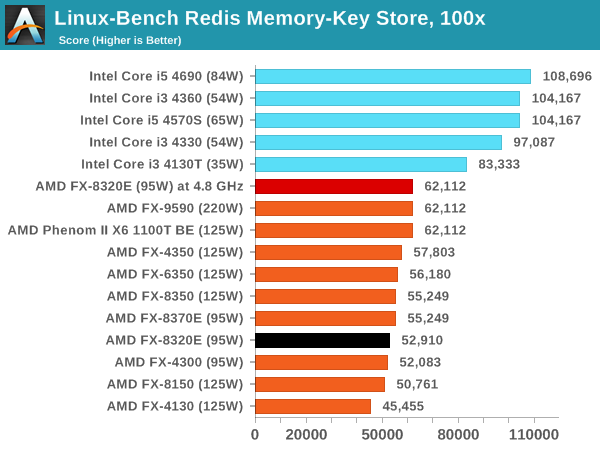
It would seem that one downside to the AMD FX line is the memory access limited scenarios, unless more cores can come into the equation. For redis, that is unfortunately not the case.










92 Comments
View All Comments
ExarKun333 - Tuesday, January 13, 2015 - link
Yeah, who needs PCIe 3.0, M.2 drives, etc? LOLroyalcrown - Tuesday, January 13, 2015 - link
M.2 is kind of dumb, stuff should just hurry up and migrate to pcieYukaKun - Tuesday, January 13, 2015 - link
You're not serious, right?The only real thing that the 990FX chipset needs is more USB3 ports and that's about it. I don't remember if the NB needs "DDR4 support" of some kind. Maybe extra interconnect logic.
PCIe 3.0 is not relevant right now since PCIe 2.0 is still enough. And not even with 3 or 4 cards in tandem, PCIe 3.0 is justifiable as a "required feature". M.2 drives... I don't even know why it is something you'd want in a desktop PC.
Cheers!
postem - Tuesday, January 13, 2015 - link
All while z97 chipset forces you to scale down PCI for every device you plug in.Intel forces chipset/socket every 2 years to force you buy new motherboards, its part of their game with their partners.
I really wish to go back to AMD, but ATM there is really not a reasonable performance cpu on their line and i really doubt will be any on foresee future.
Samus - Tuesday, January 13, 2015 - link
Intel actually launched the 90-series chipset 9 months after the 80-series. Granted, all rev C0 and newer 80-series run any CPU the 90-series does, but a lot of first adopters of the H81/H87/Z87 got screwed into no upgrade path.I agree, M2 in the desktop makes zero sense, and PCIe 3.0 is useless and will be for years. Most GPU's don't even utilize the full bandwidth of PCIe 2.0 8x.
As I said, Intel could think a little more forward (they're capable of doing so) but I think the marketing and bureaucratic politics are making the engineers push chipsets like there's no tomorrow. Intel actually makes as much selling chipsets as they do selling entry-level CPU's.
hojnikb - Tuesday, January 13, 2015 - link
>The only real thing that the 990FX chipset needs is more USB3 ports and that's about it. I don't remember if the NB needs "DDR4 support" of some kind. Maybe extra interconnect logic.Not more. 990FX doesn't even have any kind of native usb3 at all. All you see is 3rd party support via asmedia or similar chips.
So yeah, amd needs native usb3 and pcie 3.0 on their chipsets.
silverblue - Tuesday, January 13, 2015 - link
Assuming there's demand, AMD should look producing the 970 in 32nm (GF must have some spare capacity, surely?). Throw in native USB3 and halve chipset power consumption all at the same time. A 970A, if you will.hojnikb - Tuesday, January 13, 2015 - link
they never gonna do that.III-V - Tuesday, January 13, 2015 - link
>PCIe 3.0 is not relevant right now since PCIe 2.0 is still enough. And not even with 3 or 4 cards in tandem, PCIe 3.0 is justifiable as a "required feature". M.2 drives... I don't even know why it is something you'd want in a desktop PC.Lol, no matter how many times this argument gets defeated, it still pops up.
GPUs are not the only devices that utilize PCIe. Case in point: SSDs.
Cryio - Wednesday, January 14, 2015 - link
PCIe 2.0 still isn't getting maxed out. You are loosing ... 3% of performance by not going with PCIe 3.0. A lot of people don't even know what M.2 drives are.We only need proper USB 3.0 implementation. Current 970/990 chips have USB 3.0, but they're not native and not as fast.